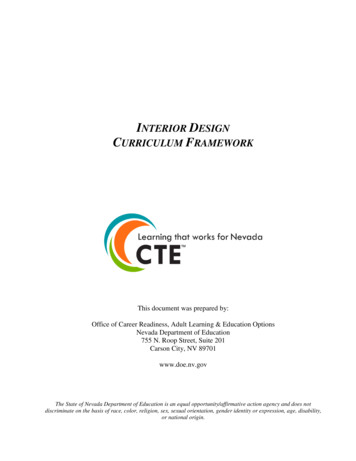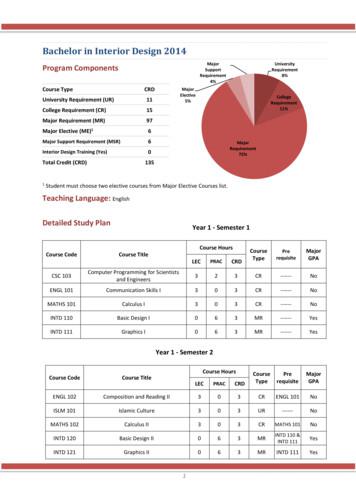VA Interior Design Manual
Office of Construction & Facilities ManagementInteriorDesign manualNOVEMBER 2020
VA Interior Design ManualNovember 1, 2020Preface/IntroductionGeneralThe Interior Design Manual provides comprehensive data sources and design linksto enable VA Healthcare Interior Designers (VAHID) and Private Sector HealthcareInterior Designers (HID) the guidance necessary to create professional interior spacesfor all healthcare environments including but not limited to Hospitals/MedicalCenters, Community Based Outpatient Clinics (CBOC), Long Term Care and ExtendedCare Facilities and Developer-Led Leased Facilities. This manual provides in-depthinformation on the VAHID role in the total design and construction project process.The Healthcare Interior Designer will have access to principles and procedures whichwhen applied to facility design, serve to enhance VA’s commitment to the higheststandards of compassion, commitment, excellence, professionalism, integrity,accountability, and stewardship.VA Outpatient Clinic - Northern Indiana Healthcare System - Mishawaka, IN.Photo courtesy of Department of Veterans Affairs.Preface/Introduction - ii
VA Interior Design ManualNovember 1, 2020AcknowledgmentsDepartment of VeteransAffairsDr. Michael D. Brennan, Ph.D., AIA, NCARBExecutive Director, Construction & Facilities ManagementOffice of Acquisition, Logistics, and ConstructionU.S. Department of Veterans AffairsJohn BulickDirector, Facilities Planning Development ServiceOffice of Construction & Facilities ManagementWashington, D.C.Donald L. MyersDirector, Facilities Standards ServicesOffice of Construction & Facilities ManagementWashington, D.C.Gary FischerSenior Healthcare ArchitectOffice of Construction & Facilities ManagementWashington, D.C.Orest BurdiakPrincipal Interior DesignerOffice of Construction & Facilities ManagementWashington, D.C.Christine Emanuelson, NCIDQ, CHIDProgram Manager, Interior DesignerEnvironmental Programs Service (EPS)VHA Health Care Environment and Facilities Programs (HEFP)Washington, D.C.Calvin ClawsonProgram Manager, Interior DesignerEnvironmental Programs Service (EPS)VHA Health Care Environment and Facilities Programs (HEFP)Washington, D.C.Rosilyn (Lyn) Palsson, NCIDQSupervisory Interior DesignerVA Southern Nevada Healthcare SystemLas Vegas, NVAnorea HillHealthcare Interior DesignerVA North Texas Health Care SystemDallas, TXAcknowledgments - iii
VA Interior Design ManualNovember 1, 2020Kelly CobbHealthcare Interior DesignerJames H. Quillen VA Medical CenterMountain Home, TNConsultants:Calvin L. HinzArchitects, P.C.Richard J. Onken, AIA, NCARB, FHFI, EDAC, USAF Lt. Col. (Ret.)President, Principal-in-ChargeElkhorn, NEGary Dubas, AIASenior Healthcare Architect, Planner, Project ManagerElkhorn, NEDebra A. Lampshire, NCIDQSenior Interior DesignerElkhorn, NEConsultants:Leo A. DalyBecky Taylor, RID, NCIDQ, ASIDSenior Interior DesignerOmaha, NE“FOR THOSE - WHO SERVED” Main Entry atOrlando VA Medical Center - Orlando, FL.Photo courtesy of RLF ArchitectureEngineering Interiors, Orlando, FL.Acknowledgments - iv
VA Interior Design ManualNovember 1, 2020OverviewVA Mission StatementTo fulfill President Lincoln’s promise- “To care for him who shall have borne the battle,and for his widow, and his orphan” -by serving and honoring the men and womenwho are America’s Veterans.VisionTo provide Veterans the world-class benefits and services they have earned and todo so by adhering to the highest standards of compassion, commitment, excellence,professionalism, integrity, accountability, and stewardship.Executive SummaryThe VA Interior Design Manual (IDM) will provide VA staff and healthcare interiordesign teams (HIDT) an understanding of their roles, responsibilities, and theappropriate procedures for creating a safe, accessible, and healing environment– designs that are enduring and take into consideration durability, feasibility andsustainability. All VAHID and HID supporting new construction, renovation, anddeveloper-led lease projects are expected to follow this manual.The purpose of the IDM is to aid in the translation of VA design manuals, guides,and master specifications into patient-centric design solutions. VA strives for designsolutions that improve the quality of life and productivity as well as protect thehealth, safety, and welfare of the Veterans, visitors, and staff. Interior design is a majorcomponent in establishing and maintaining an environment that is therapeutic, safe,aesthetically pleasing, functionally appropriate and professional.The IDM will provide tools for understanding current healthcare design industrystandards as well as innovative out-of-the-box thinking balanced with a clearawareness of what designing for VA means.The IDM is a living document that VA staff will support and contribute to in futurerevisions, therefore creating a sense of ownership and collaboration between the VAstaff and VA Central Office.Internal links are provided to other VA architectural standards and criteria documentsto make this manual more user-friendly. The HIDT will utilize VA architecturalstandards and criteria documents as a basis of design located on the VA TechnicalInformation Library (TIL), and all applicable building codes and industry standards.The IDM is the resource to help build the rationale for options and challenges tothe aforementioned standards and is a companion manual to the ArchitecturalDesign Manual (ADM), which provides check lists to organize the design processfrom preliminary/ conceptual design into architectural criteria and best practicethroughout the design approach.The IDM is also intended to be a companion to the design guides. The designguides provide functional and space criteria that are illustrated with architectural,equipment, and environmental requirements into room templates. See VA Standardsand Criteria within this Section 2: Design Principles.Overview - v
VA Interior Design ManualNovember 1, 2020Interior Design is a multi-faceted profession in which creative and technical solutionsare applied within a structure to achieve a built interior environment. These solutionsare functional, enhance the quality of life and culture of the occupants, and areaesthetically attractive. Designs are created in response to and coordinated withthe building shell and acknowledge the physical location and social context of theproject. Designs must adhere to code and regulatory requirements and encouragethe principles of environmental sustainability. The interior design process followsa systematic and coordinated methodology, including research, analysis, andintegration of knowledge into the creative process, whereby the needs and resourcesof the client are satisfied to produce an interior space that fulfills the project goals.Interior design includes a scope of services performed by a professional designpractitioner, qualified by means of education, experience, and examination,to protect and enhance the life, health, safety, and welfare of the public.All VA Healthcare Interior Designers (VAHID) and private sector Healthcare InteriorDesign Teams (HIDT)should reference the National Council for Interior DesignQualifications (NCIDQ) definition of interior design found at www.cidq.org. NCIDQcertification is a means to identify interior designers who have demonstrated aminimum level of competence needed to practice interior design.Outpatient Waiting Area at the Clinic Addition, VA Biloxi Medical Center, Biloxi, MS.Photo courtesy of Leo A. Daly, Architects/Engineers, Omaha, NEOverview - vi
VA Interior Design ManualNovember 1, 2020Table of wTable of Contents:Section 1Project Foundation.11.1 Project Foundation:y Scope of Worky Funding Structure1.2 Integrated Design Process and Healthcare Interior Designer’s Roles:y Integrated Design Process (IDP)y Interior Designer’s Rolesy Preliminary/Conceptual Designy Schematic Designy Design Developmenty Contract Documentationy Bidding, Construction, Commissioningy Timeline Developmenty Activationy Post Occupancy Evaluation1.3 VA Space and Equipment Planning System (VA SEPS)y VA SEPSy Joint Schedule Numbers (JSN)y VA Acquisition Codes1.4 Building Information Modeling (BIM)Section 2Design Principles.132.1 VA Standards and Criteria:y Office of Construction & Facilities Management (CFM)y Technical Information Library (TIL)y VA Program Guides, Manuals, and Standardsy VA Standards Alerts (SA) and Design Alerts (DA)2.2 Infection ControlTable of Contents - vii
VA Interior Design ManualNovember 1, 20202.3 Fundamental Design Considerationsy Design Storyy Patient Privacyy Patient Profiley Healing Environmentsy Evidence-Based Designy Patient-Centered Carey Whole Health Carey Physical Environmenty Accessibilityy Sustainable Designy Design Elements of the Healing Environmenty Indoor Air Qualityy Organizational Planningy Patient Experience Enhancementsy Materials Appropriatenessy Budget Realism2.4 Emerging Healthcare Design:y Future Flexibilityy Safetyy Minimizing Stress2.5 Technology2.6 Core Elements & Other Considerations:y Vision and Intenty Decision Criteriay Conceptsy Design Approachy Team Structurey Ideas and Innovationy Interior Finishes Options and Presentationy Solutions and Final Presentationy Reporting and Approval Structurey Standard Details2.7 Toolboxy Generaly Wall Protectiony Ceilingsy Lightingy Color Theoryy Pattern and Texturey Materialsy Casework, Millwork and Modulary Signage and Wayfindingy Furniture/Textilesy Tools for Tracking Cost2.8 VA Facility-Level Interior Design StandardsTable of Contents - viii
VA Interior Design ManualNovember 1, 20202.9 Acquisition of Artwork and Decorative ItemsSection 3Construction and Projects.463.1 Construction and Projects Support:y Healthcare Environment and Facilities Programs (HEFP)y Capital Asset Management (CAM)y Healthcare Engineering (HE)y Environmental Programs Service (EPS)y Occupational Safety & Health (OSH)y Strategic Capital Investment Process (SCIP)Section 4Accreditation and Regulatory Standards.484.1 Accreditation and Regulatory Standards:y The Joint Commission (TJC)y Commission on Accreditation of Rehabilitation Facilities (CARF)y Long Term Care Institute (LTCI)y Health Insurance Portability and Accountability Act (HIPAA)y VA Codes, Regulations, Standards, Directives, Executive Orders, Alerts,and MemorandumsSection 5Glossary.505.1 Glossary of Terms5.2 Acronyms and AbbreviationsSection 6Resources.596.1 Internal Resources6.2 External ResourcesAppendix A.63Appendix B.66Table of Contents - ix
VA Interior Design ManualNovember 1, 2020Section 1: Project Foundation1.1 Project Foundation.2y Scope of Worky Funding Structure1.2 Integrated Design Process and Healthcare Interior Designer’s Roles.3y Integrated Design Process (IDP)y Interior Designer’s Rolesy Preliminary/Conceptual Designy Schematic Designy Design Developmenty Contract Documentationy Bidding, Construction, Commissioningy Timeline Developmenty Activationy Post Occupancy Evaluation1.3 VA Space and Equipment Planning System (VA SEPS).9y VA SEPSy Joint Schedule Numbers (JSN)y VA Acquisition Codes1.4 Building Information Modeling (BIM).11Section 1 - 1
VA Interior Design ManualNovember 1, 20201.1 Project FoundationScope of WorkVA Staff are responsible for developing a Scope of Work (SOW) for the selection of A/Efirms for the full development of the project. The SOW will outline project basics such asdepartment, estimated square feet, design considerations, expectation of materials andfinishes, construction budget, and other items specific to the project. The VA HealthcareInterior Designer should participate in the development of the project SOW.Funding StructureVA has five levels of funding construction projects. Each level is defined by size andcost. VA staff and the Healthcare Interior Design Team (HIDT) participating in designprojects should be aware that some or all of the funding structures may be affected.Station Level Projects - Construction, renovation, or Non-RecurringMaintenance and repair projects where there is minor improvement, not a minorproject. Station level projects are funded as a lump sum figure in the NonRecurring Maintenance program.Non-Recurring Maintenance (NRM) - Renovations, repairs, maintenance, andmodernizations of the existing infrastructures. NRM focuses on correcting the FacilityCondition Assessment (FCA), ensuring the medical center meets applicable codes. NRMmodernizes within the existing constraints of the infrastructure to comply with currentstandards of care and allows for stand-alone demolition, new surface parking, androads. Funding threshold is capped at 20M. Veterans Equitable Resource Allocation(VERA) is approved by Veterans Integrated Service Network (VISN). Special programfunds are approved by Veterans Health Administration Central Office (VHACO)Minor Projects - Minor construction projects that expand the existing facility by1,000 GSF or more; projects addressing workload gaps, providing access to care forVeterans, parking structures, and seismic projects. The decision level for selection ofminor projects are made at VHACO through national prioritization and is executed bythe medical center. The funding threshold iscapped at 20M and approved by VISNand VHACO.Major Projects - New construction,new hospitals and 100% renovationimprovements to medical centers to providestate-of-the-art health care. The decisionlevel for selection is made at VHACO. Majorprojects are those over 20M and funding isappropriated annually by Congress.Main pedestrian concourse at Rocky Mountain Regional VA Medical Center - Denver, CO.Photo courtesy of SOM Christopher Barrett Photography.Section 1.1 - 2
VA Interior Design ManualNovember 1, 20201.2 Integrated Design Process and Healthcare InteriorDesigner’s RolesIntegrated Design Process(IDP)VA utilizes the Integrated Design Process (IDP) during the architectural planning anddesign of VA facilities. The IDP process interlaces the disciplines to provide full andconstructive participation of all members of the design and project delivery teamwith a focus on collaboration ensuring the best results. The IDP facilitates the increaseof project efficiency by bringing all stakeholders to the table.Interior Designer’s RolesPreparation for a project is led by the VA who identifies the program needs for thefacility renovation or expansion for design/construction projects based on quantifiablerequirements for space and budgetary capacity to undertake the activity. The VAprepares a needs assessment that describes the space use; develops estimates ofrequirements both spatial and technical; initiates assessment of possible environmentalimpacts and arrives at a Space and Equipment Planning System (SEPS) generatedProgram for Design (PFD) around which design activity can develop. It is critical that VAHealthcare Interior Designers are involved in the project preparation stage.The following sections detail the VAHID role in the typical facility design/developmental process.Preliminary/ConceptualDesignAs a key participant at the kickoff meeting, it is appropriate for the VAHID to comeprepared with a full understanding of the project scope, space requirements, SEPSgenerated program for design, and associated CFM design standards. In addition, theVAHID provides the design team a copy of the established material and facility finishstandards. Additional guidance and/or emphasis on critical design-related concernsshould be shared and addressed at this early stage of the project. Examples of interiordesign-related goals:y Participation of VAHID throughout full design and planning processy Efficient space allocation and planningy Visual and or ambient enhancement of the interior spacey Implementation of VA Interior Design standards within the designy Development of lighting designy Signage and wayfinding designy Ensuring the integrity of the interior design goals are maintained as the processof estimating, design, and construction proceeds.Schematic DesignOnce the preliminary/conceptual design is complete, the Schematic Designphase begins with the design team providing an initial block plan layout basedon the appropriate facility VA design guide/manual, the approved SEPS programrequirements, and any pertinent project information ascertained during the projectkickoff meeting. The intent of this phase is to stimulate thought, discussion, andbring structure to the stakeholders’ understanding of the project requirements andlimitations, not necessarily to produce the final outcome.Involvement of the project design team is a critical element of the process. Theproject design team includes VA SMEs’ such as Program Office Leadership, EMS,Logistics, A/E of Record, HID’s and other consultants that may be involved. Such asbut not limited to the VA design team, Owner/Developer for lease projects, Architect,Section 1.2 - 3
VA Interior Design ManualNovember 1, 2020Healthcare Interior Designer, Engineers, and Builders. Their individual insights canprevent costly changes further along in the process. Gradually, a design evolves whichembodies the vision and requirements of all participants while also meeting the projectrequirements established during preliminary design. The resulting schematic designsolutions produced at this stage show site location and organization, general buildingshape, space allocation, and include an outline specification which makes an initiallist of components and systems to be designed and/or specified for the final projectdesign. A preliminary cost estimate by a professional cost estimator is recommended.During this phase, the Healthcare Interior Designer collaborates with the VAHIDto develop solutions to meet the team requirements. These could include meetingthe established goals pertaining to but not limited to the function, accessibility,sustainability, material selections to achieve the defined aesthetic of the spaces,identifying design elements, and developing Furniture, Fixture, & Equipment(FF&E) layouts.Primary Care Clinic at VA Southern NevadaHealthcare System - Las Vegas, NV.Photo courtesy of Apogee Consulting Group.Design DevelopmentDesign Development further defines and refines the schematic design with greaterdetail for all aspects of the project. During this phase, the HID works integrally with theproject design team and VA stakeholders to enhance the function, desired aesthetic ofthe various spaces, refine the proposed material selections and assist with the estimates/life cycle cost analysis to determine the impact of the desired material choices.Room numbering methodology following the VA Signage Design Manual should beestablished by the end of this phase. During this phase, branding initiatives,wayfinding themes, and navigational strategies are developed and presented toexecutive leadership for approval. It is recommended to “socialize” the designapproach of the project with the end-users and Veterans to encourage theirfeedback and buy-in to the project.Section 1.2 - 4
VA Interior Design ManualNovember 1, 2020The conclusion of this phase is a detailed design on which all VA stakeholders agreeand may be asked to sign-off/approve the documentation.All interior design t
VA Interior Design Manual November 1, 2020. Interior Design is a multi-faceted profession in which creative and technical solutions . are applied within a structure to achieve a built interior environment. These solutions are functional, enhance the quality of life and culture of the occupants, and are aesthetically attractive.
Interior Design I L1 Foundations of Design* L1 Interior Design II L2 Interior Design II LAB* L2L Interior Design III L3C Interior Design III LAB* L3L Interior Design Advanced Studies * AS *Complementary Courses S TATE S KILL S TANDARDS The state skill standards are designed to clearly state what the student should know and be able to do upon
Aug 27, 2006 · The Interior Design Manual (IDM) will provide VA staff participating in the development of interior design projects with an understanding of their roles, responsibilities and the appropriate procedures for creating a comprehensive Interior Design environment. All VA staff members taking part in interior design are expected to follow this manual
What is Interior Design? Interior Design is a "unique blend of art and science. Interior decorating is the embellishment of interior finishes and the selection and arrangement of fabrics and furnishings" according to Beginnings of Interior Environment by Phyllis Sloan Allen, Lynn M. Jones and Miriam F. Stimpson. Interior designers are trained .
interior spaces, interior surfaces, furniture, and ornamentation. Course Code: INTD 216 Course Title: Color in Interior Use of color in interiors. Emphasis on color theory, psychology of color and its effects on moods. Application of color in interior environments with lighting conditions. Course Code: INTD 220 Course Title: Interior Design II
Figure 6: 3 sub-segments of interior design firm’s client. 17 Figure 7: Customer segment of interior design market 19 Figure 8: Logo of TIDA (Thailand Interior Designer association) 20 Figure 9: Design process 21 Figure 10: Schematic design 22 Figure 11: Interior turnkey scope of
is a need for interior design textbooks to reflect this context and allow interior design students to keep pace with rapid development of the industry. This series of interior design textbooks is aimed at satisfying the needs of Hong Kong interior design students at different academic levels from diploma, higher diploma to bachelor's degree .
INTERIOR DESIGN & BUILD ISLE OF WIGHT joisleofwight@yahoo.com 07964829997 www.coastiow.co.uk COAST IOW LTD INTERIOR DESIGN & BUILD Curabitur leo. COAST IOW LTD INTERIOR DESIGN & BUILD . Coast IOW Ltd - Interior Design Portfolio Created Date: 6/8/2021 8:14:52 AM .
how they applied BIM in the interior design development. Taking full advantage of BIM from basic to detailed interior design Using BIM for interior design Ikeda Architecture www.ikeda-architecture.jp Established in : 2010 Representative: Yoichiro Ikeda Speciality: Shop design interior Head Office: Yokohama, Japan Software: ARCHICAD, BIMx






















